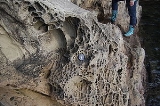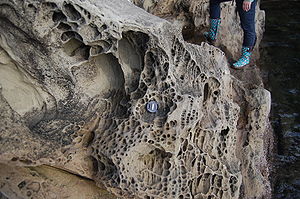
Honeycomb weathering
Encyclopedia

Tafoni
Tafoni are small cave-like features found in granular rock such as sandstone, with rounded entrances and smooth concave walls. They often occur in groups that can riddle a hillside, cliff, or other rock formation. They can be found in all climate types, but are most abundant in intertidal areas...
weathering (Mustoe, 1982) is a type of salt
Salt
In chemistry, salts are ionic compounds that result from the neutralization reaction of an acid and a base. They are composed of cations and anions so that the product is electrically neutral...
weathering
Weathering
Weathering is the breaking down of rocks, soils and minerals as well as artificial materials through contact with the Earth's atmosphere, biota and waters...
common on coastal and semi-arid granite
Granite
Granite is a common and widely occurring type of intrusive, felsic, igneous rock. Granite usually has a medium- to coarse-grained texture. Occasionally some individual crystals are larger than the groundmass, in which case the texture is known as porphyritic. A granitic rock with a porphyritic...
s, sandstone
Sandstone
Sandstone is a sedimentary rock composed mainly of sand-sized minerals or rock grains.Most sandstone is composed of quartz and/or feldspar because these are the most common minerals in the Earth's crust. Like sand, sandstone may be any colour, but the most common colours are tan, brown, yellow,...
s and limestone
Limestone
Limestone is a sedimentary rock composed largely of the minerals calcite and aragonite, which are different crystal forms of calcium carbonate . Many limestones are composed from skeletal fragments of marine organisms such as coral or foraminifera....
s (Mustoe 1982). Honeycomb weathering is not limited to natural settings and can be seen to develop on buildings where a rate of development can be established. This rate can be as fast as several centimeters in 100 years (Mustoe 1982). Honeycomb weathering occurs throughout the world from the polar regions (French and Guglielmin 1999) to the equator. There are two distinct types of coastal honeycomb weathering intertidal and supratidal.
Cause
For honeycomb weathering to occur, a source of salt is needed because the basic mechanism for this kind of weathering is salt heaving. Salt is deposited on the surface of the rock by saltwaterSeawater
Seawater is water from a sea or ocean. On average, seawater in the world's oceans has a salinity of about 3.5% . This means that every kilogram of seawater has approximately of dissolved salts . The average density of seawater at the ocean surface is 1.025 g/ml...
spray or by wind
Wind
Wind is the flow of gases on a large scale. On Earth, wind consists of the bulk movement of air. In outer space, solar wind is the movement of gases or charged particles from the sun through space, while planetary wind is the outgassing of light chemical elements from a planet's atmosphere into space...
. Moisture must be present to allow for the salt to settle on the rocks so that as the salt solution evaporates the salt begins to crystallize within the pore-spaces of the rock. Porous rock is also needed so that there are pore-spaces for the salt to crystallize within. These salt crystals pry apart the mineral grains, leaving them vulnerable to other forms of weathering. It takes prolonged periods for this weathering to become visible, as the rock goes through cycles of wetting and drying.
Intertidal honeycomb weathering is found on horizontal planes in rock within the tidal zone. This type of honeycomb weathering is limited in its growth by the rate of evaporation from the sun. Once the depressions have grown large enough that the sun can not evaporate all of the water left in the gap by the retreating wave, the holes are as large as they will get, because the salt can not dry out and wedge grains apart any longer.
The cause of the characteristic honeycomb pattern in supratidal areas on the vertical plane is still under debate. Some geologists believe that the side walls of the alveoli may be protected from salt weathering by microscopic algae
Algae
Algae are a large and diverse group of simple, typically autotrophic organisms, ranging from unicellular to multicellular forms, such as the giant kelps that grow to 65 meters in length. They are photosynthetic like plants, and "simple" because their tissues are not organized into the many...
(Mustoe, 1982), while others believe that case-hardening, wind and sun exposure, wetting and drying cycles or mineralogical variations within the stone may be responsible. Most likely, a combination of these factors produce these delicate structures.
Research
Honeycomb weathering has been studied using Scanning Electron MicroscopeScanning electron microscope
A scanning electron microscope is a type of electron microscope that images a sample by scanning it with a high-energy beam of electrons in a raster scan pattern...
(SEM) imaging, laboratory reconstruction of weathering conditions, Mass Spectrometry
Mass spectrometry
Mass spectrometry is an analytical technique that measures the mass-to-charge ratio of charged particles.It is used for determining masses of particles, for determining the elemental composition of a sample or molecule, and for elucidating the chemical structures of molecules, such as peptides and...
, Electron Diffraction Spectroscopy (EDS) and other techniques. It has been studied extensively as it is responsible for the slow destruction of many historical sites worldwide including, the ruined city of Petra, Jordan, and the sea walls of Weston-super-Mare
Weston-super-Mare
Weston-super-Mare is a seaside resort, town and civil parish in the unitary authority of North Somerset, which is within the ceremonial county of Somerset, England. It is located on the Bristol Channel coast, south west of Bristol, spanning the coast between the bounding high ground of Worlebury...
, UK.

